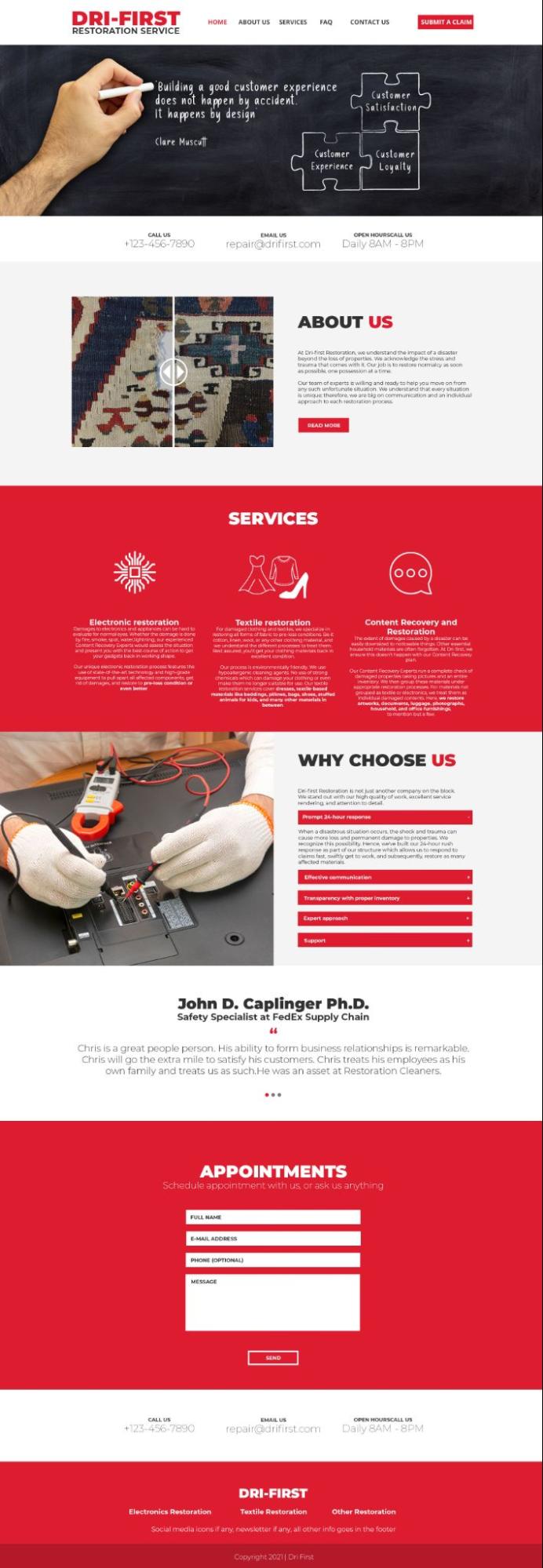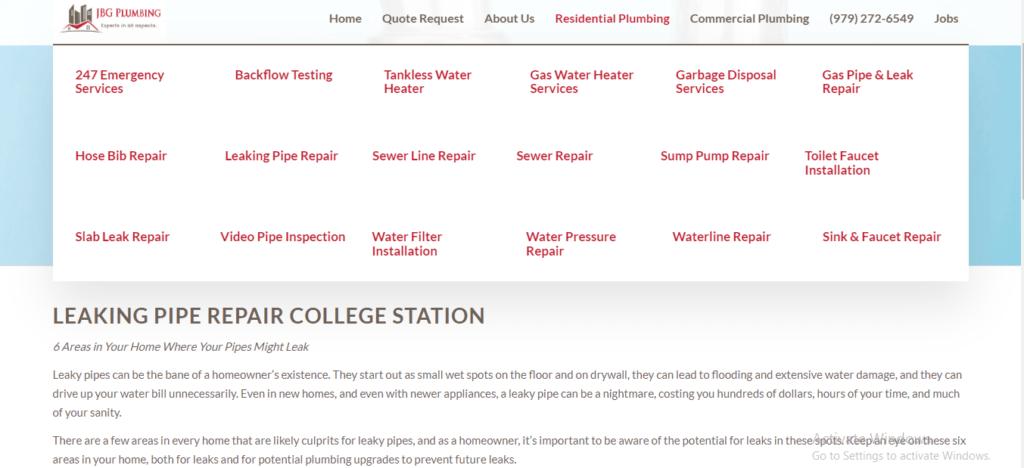Oluwadunmola Adefioye | Updated: June 1, 2023 | Home services websites

With more customers preferring to hire service professionals with an online presence, businesses need an optimized website now more than ever. As an experienced home contractor website agency, we have put together this comprehensive guide to help you learn all that goes into making your home service website a lead conversion tool.
So, sit back, put away your handyman tools for a couple of minutes, and let’s talk about home contractor websites and how to optimize them for conversion.
What does it take to build a home contractor website? That’s what we will be discussing today under this step-by-step guide. In addition, this section will help you understand the rudiments of creating a distinctive online brand.
We will go through the entire website design, development, and maintenance process as they apply to the home service industry. These are the three arms of website optimization. You must get it right with design, development, and maintenance to perform above the competition.
Here’s how you can go about that:
Contractor website design is the core of optimized conversions for any home service business, as it constitutes the framework upon which every other website component is built.

There are different schools of thought in web design: the Dynamic approach, Static web design, and Conceptual or Experimental designs. However, we recommend staying with the dynamic and static website design for home services web design.
Dynamic design approaches focus more on visual displays to engage the user. It works well for general contractor websites, masons, painters, and other structural home service businesses.
Whereas a content-led angle of static website designs works well for businesses that need to empathize with the target clients. For example, home restoration services, plumbing businesses, and HVAC services, among others.
A responsive design is crucial to user engagement for contractor websites. Here’s how you can build towards that;
Local businesses in the home improvement industry are generally service providers. Hence, the standard website functionalities in this niche highlight the unique propositions and credibility of the service rendered.
For example, opting for an e-commerce functionality like a checkout tool on your website instead of a call-booking feature might lead to fewer conversions. Customers have different needs; some can’t even describe their problems well. So, they need your expert evaluation before you can talk about pricing.
After you have determined the features and functions you need on your website, the next step is to map its layout. Some user actions are more important to your business’s bottom line than others. Therefore, these actions must be prioritized while arranging the page buttons and dropdown menu.
Getting more client calls is a priority for home improvement businesses. So also is getting potential customers to trust you, showcasing your expertise and experience, and showing that you understand the customer’s challenges and fears.
How do you factor all of these into your website structure?
You would do that by deploying navigational elements into your contractor website design. This means that priority business goals take the top call-to-actions. Then, the links and navigation pointers, like a bar menu or a search bar, would help website users find other key features. These will take your web visitors steps closer to becoming paying customers.
Part of planning your home service website is also factoring in technical SEO requirements. This especially has to do with planning how your web pages would link together and are all accessible to search engine crawlers using an .xml file. Luckily, if you use a content management system like WordPress, you don’t need to worry about creating a sitemap for your website. This only comes into play when you run a custom coded website.
The agreed functionalities and proposed structure come to life with a web design mockup. A mockup is like a blueprint of what your website will look like after it’s developed.
While it’s best to go with a custom design experience for your home service business, there is also the option of using a pre-designed template. Using a template might save you some cost and time, but it offers less flexibility and might not offer you specific design features.
Before you decide on a web design mockup or template, pay attention to the typography, the visuals, and the color patterns. Consider settling for legible fonts and colors that allow users to see what your business offers. And the visuals, which include images and illustrations, need to match the messaging. For example, a casual image of a pet or a kid doesn’t match the messaging of professionalism and expertise.
A website’s back-end development is how the website design is implemented. The development process of a website starts with tertiary actions like domain registration and securing web hosting services. After that, building work commences, which varies for different websites.
Let’s dive right into the nitty-gritty of web development as it concerns home service businesses;
If you’re building a new website for your home service brand, you need to secure a custom domain name and a hosting plan before you can start building your website.
Securing a domain name isn’t as techy as it sounds. You only need to check if your preferred website name is available and then purchase it if it’s available. If you’re thinking of a familiar business name, you should check its availability as a domain name before deciding. This helps solidify your brand name without compromising domain name spelling.
On the other hand, hosting is a renewable service you can get from different providers. You should compare the offers of different hosting services before deciding. Here are some factors to consider (not exhaustive);
After your domain and hosting are settled, you need to decide on the content management system, CMS, which would be used to manage your website from the backend.

Usually, most local business owners work with WordPress because it’s open-source, free to use, and there are loads of free plugins to get you going. It’s also relatively easier to navigate the admin dashboard and its editor mode and add basic themes.
However, if you’re looking to pull off something special, like an experimental web design to showcase the peculiarity of your brand, then you would need a custom CMS built from custom code. Of course, this is a more expensive and resource-intensive route, but the customization possibilities are limitless.
After a content system is set up on your website server, you’re set to put up your website content. Almost everything you see on a website is content – images, videos, page text, audio files, and blog articles. The best way to approach your home service website content is to prepare them ahead of time.
Once you have your web design mockup or template, determine which visual content goes where and have the documents ready. This makes the work much more manageable and hassle-free.
When uploading content blocks, pay attention to the title box and ensure they are more conspicuous, relatable, and persuasive for the target audience.
Before your home contractor website goes live, ensure that you test all the features and functions on multiple devices and browsers. Also, try to get a second pair of eyes to bring a fresh perspective. Finally, you can get a verdict from an ideal prospective client who fits your website’s target audience.
Home contractor websites are like motor engines; they need regular maintenance to maintain optimal functional capacity. To do this, you need to know your way around the administrator dashboard on your website’s backend.
Learning to perform basic edits on your website for a CMS like WordPress is crucial. For example, you should be able to update promotional offers or create user accounts for your website. However, some other critical features require the skilled expertise of a professional web developer (that’s where Klutch Growth comes in 😉).
Signing up for a home service web agency service to help with frequent website updates can help improve your home service website’s overall performance and increase conversions. Fixing broken links, updating website structure, and monitoring changes in load time and server response are some of the services included in a comprehensive website maintenance package. You can learn more about our services on our web services page.
A common goal for most home contractor websites is to generate more qualified leads. And one of the surefire ways to do this is through organic traffic.
When someone searches for your service online and finds your business without you running an ad campaign, that is an organic result. The best way to generate organic traffic is to rank your website on search engines.
Search engine optimization is continuous and can be roped into web maintenance. Especially when it comes to technical SEO updates, this has more to do with the backend than with the content of blog posts or merely adding internal links and title tags. To get the best results from SEO, engage both valuable content and technical bits.
What makes a contractor website more effective? It goes beyond creating a stunning website design alone; there are other details you must factor into your home improvement website.
Here are some for your perusal;
There are over 4 billion mobile internet users as of 2021, accounting for about 60% of the total online traffic. If your home service website is not mobile responsive, you will lose more than half of your potential qualified leads.
Creating a mobile-friendly website is crucial to attracting more potential customers. A responsive website can adjust to the mobile browser dimensions and not appear distorted. If your website is only suitable for computer browsers, you will leave a lot of money on the table.
A website’s content is beyond simply stringing words to fill the canvas. You have to strive to communicate your business value clearly and empathically. This starts with proper grammar and punctuation – a well-written homepage invites the website user to check other pages.
You should be wary of using technical jargon for your home improvement website. For example, as a plumber, your customers won’t relate well to the dimensions and internal pressure rating of pipes. However, they would find it helpful when you explain how to stop a leaking faucet with simple hacks.

The best way to engage website users is to show how you can solve their problems. Hence, blog posts are essential. More so, helpful content also boosts your site’s search engine rankings in the long run.
Every page of your website must have clear call-to-actions you want customers to use. For example, on the homepage, this could be ‘Book a free consultation’ or “Place a call.”
You can use ‘Get a free quote’ for your services page.
For your brand’s about page and contact pages, you can get customers to fill out your contact form.
And on blog pages, you can have them click a link to read more.
To complement the valuable content on your website, you need to match it with visual storytelling. Visuals include relatable images and graphic illustrations arranged to elicit specific emotions from site visitors.
Best practices include avoiding blurry images, properly aligning header images, keeping the image size small to improve website load time, using personalized images from past projects, and only opting for stock images with a legal image source. In addition, you want to avoid images that are subject to copyright.
Better still, you should display your expertise by keeping a portfolio gallery of past home improvement jobs you’ve completed. Other ideas include using animated illustrations which use artwork to make an impression on your customers. A classic example would be an animation of Winnie the Handyman fixing a leaky faucet.
Another way to improve user experience on your home service website is by using interactive features like swipe actions, mouse interactions, hover effects, animated buttons, and a host of other micro-interactions for websites.
What these interactions do is that they help engage potential customers on your website while you get to lead them toward your business value proposition. A classic example is to use a hover effect to showcase the fine details of a painting job on a painter’s website, supported with an appropriate call to action.
Turning website clicks into service-qualified leads boils down to structuring your website pages. You don’t have to shove contact forms and signup pages in web users’ faces at every turn. Instead, you only need to place the forms on strategic pages that generate the most traffic on your website.
Potential customers are more eager to register their email addresses when they want to learn more about what you offer. This means you’d get better leads with forms on the services page, the home page, and cluster topics.
Granted, many websites don’t have accessibility features that cater to persons with disabilities (PwDs). However, it doesn’t require advanced functionality additions; it starts with overlooked steps like adding proper alt texts to images, using more neutral colors, making your links descriptive, and structuring your content with headers.
As it is with accessibility, if you plan to get traffic from regions with multiple languages, you should consider making your home contractor brand a multilingual website. For example, if you operate in Canada, you might want a french version of your English website.
How do you get prospective clients to take action on your website? It’s by optimizing your web pages for conversion. We have trust building, location coverage, unique value proposition, and promotional offers at the core of conversion optimization for home service businesses.
Here are some ideas for working these optimization points into your contractor website.
Gaining the trust of potential clients using your website is best done by showing how you can solve customer problems. So, instead of raving about how good your services are on your website, you should talk more about how your services have helped previous customers to achieve their dream homes.
A lot of home service businesses believe in using case studies as a form of social proof to improve their brand’s trustworthiness. But if you do that, then, your website isn’t really going to stand out. Instead, you can try a new touch of integrating your customer reviews and case studies from past projects within regular posts. You would use your client reviews to both capture attention and also to convince your website visitors. It’s a form of showing how you deliver satisfactory services, and not just telling them about your business.
Another idea to improve customer affinity for your brand is by providing free DIY tips to solve everyday home maintenance problems. Providing accessible information tells your readers that you deeply care about solving their problems; hence, they trust your business more. And when they need a professional to handle their home servicing, they’ll think of your business first.
Showcasing completed projects on your contractor website helps build trust with new clients. However, you can take it further by using customer testimonials and reviews. What good things have previous clients said about your brand? You can add those good words as social proof on crucial pages of your website. This would highlight your professionalism, as well as bolster your online reputation.

Most businesses in the home service industry work based on location coverage. It has to be clear from your website the physical location your services reach. You always want to generate leads that are within your coverage area. According to ThinkWithGoogle, 76% of location-specific searches lead to visiting the business within a day.
So, in optimizing your home improvement website, you need to target location-specific keywords like “plumbers near me” for the regions you service. You can also get your business details on Google Maps for more specificity. Local SEO is quite a big deal in the home care industry. Customers are looking to hire the most reliable business that is closest to them. So, putting your brand on the map can literally bring more online customers through your doors. Especially for home owners new to your neighborhood.
Local SEO works by optimizing your business name, address, and phone number (NAP) on trusted service listings online, starting with Google My Business. Then, you would also add your website link and social media handles, and a host of other details. To better position your website for local SEO, it’s best to include a location page. This is compulsory if your business operates in more than one service areas. Create location pages and then drop Google Maps Pack widget to pinpoint your exact coverage area.
You need to make it easy for website visitors to pick up their phones and call your business line. The easiest way to do this is to pin your contact information to your website bar menu and on the footer menu at the bottom of each page. More home service business websites are adopting this style, which has helped improve lead generation.
To even better your chances of closing more leads with your website design, you should use upgrade your contact information to a clickable button. For Klutch Growth, we use a Calendly link within a “Let’s Talk” button. It can be anything more actionable for your business. And it can be used on any page, including blogs, in which the context fits.
Building customer loyalty starts by helping website users find helpful information through blog articles, case studies, home improvement podcasts, and videos. Educating your readers makes them see your website as an information hub.
Then, that also increases the chances of them sharing your website with other prospective customers. You can generate ideas and writing tips for your website by asking your audience via email, social media, or blog comment section. You can also discuss the trend of modern technologies in your home service area; these trendy discussions generate lots of buzz and can get more paying customers through your doors.
A unique value proposition is a specific offering that separates your home service business from competitors. Something you can say to customers to make them choose your business over others. Whatever this is, you need to make it known on your website’s main pages, like the homepage and services pages. An example of a value proposition for a home restoration company could be free logistics for restored materials.

Viewers retain more than 90% of what they learn in videos. This makes videos viable tools on your website homepage; they can help drive customer actions. Videos are also great as an educational resource to drive customer retention. One way to use videos for lead capturing is through the YouTube platform, a form of social media to drive traffic to your website.
Several website visitors would be curious about your services and how they can work with your business on their home projects. An excellent way to stay ahead is to have FAQ sections on your services pages and blog articles. Answering frequent questions doesn’t only satisfy customer curiosity; it also helps your pages rank better on search engines.
Pop-up pages can be used as a secondary navigational element on your website to drive traffic to specific pages or offers. Usually, businesses can use pop-ups to present exclusive offers like a discount link or a free resource, which serves as incentives for fueling a needed action like signing up for an email list.

Promotional offers drive immediate traffic and can provide a boost in conversions. If you need to highlight some of the services you render for more customers to see, you can put it up as a special offer on your website. You can offset the urgency and discounts accrued with offers like this with increased leads and overall customer lifetime value.
WordPress is the best website builder for local home services businesses because it’s free to use and has loads of free plugins and essential elements to kickstart a website. Also, learning how to use the admin dashboard is pretty straightforward, meaning website owners can make minor website updates without much technical knowledge.
A template website design is suitable for a quick website with few interactions expected. But it’s best to design a completely custom website that matches your brand for a home contractor website. A basic theme on WordPress works quite well, and you can get maximum website performance when you have a professional set it up.
For a home contractor website, you need a homepage, a services page, a contact page, and an about us page are the basic required pages. But for better optimization, you should have a blog and add FAQs to your pages.
Creating a new business website takes an average of three to six weeks. Factors that affect the duration include the choice of CMS, whether or not the website is entirely custom, availability of webpage content, and additional website functionalities, among others.
Building an online presence for your home service brand is only possible with a correctly set up website. And building just any website isn’t enough; you have to optimize it for lead conversions. Now that you know how to make your contractor website more productive, it’s time to implement.
What you should look for on your home contractor website:
Klutch Growth helps home service businesses to build high-converting websites that reshape their online marketing efforts. We offer web design, development, and maintenance services for all home service niche businesses. Check our services page for more information.

I enjoy writing engaging and practical articles that help local businesses grow. That’s why I take my time to understand the industry - customers and businesses - before writing a word.
Aside from content marketing, I enjoy watching football and love my beloved Arsenal FC.
Hire Klutch Growth